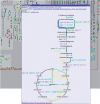The MetaCyc database of metabolic pathways and enzymes and the BioCyc collection of pathway/genome databases
- PMID: 19850718
- PMCID: PMC2808959
- DOI: 10.1093/nar/gkp875
The MetaCyc database of metabolic pathways and enzymes and the BioCyc collection of pathway/genome databases
Abstract
The MetaCyc database (MetaCyc.org) is a comprehensive and freely accessible resource for metabolic pathways and enzymes from all domains of life. The pathways in MetaCyc are experimentally determined, small-molecule metabolic pathways and are curated from the primary scientific literature. With more than 1400 pathways, MetaCyc is the largest collection of metabolic pathways currently available. Pathways reactions are linked to one or more well-characterized enzymes, and both pathways and enzymes are annotated with reviews, evidence codes, and literature citations. BioCyc (BioCyc.org) is a collection of more than 500 organism-specific Pathway/Genome Databases (PGDBs). Each BioCyc PGDB contains the full genome and predicted metabolic network of one organism. The network, which is predicted by the Pathway Tools software using MetaCyc as a reference, consists of metabolites, enzymes, reactions and metabolic pathways. BioCyc PGDBs also contain additional features, such as predicted operons, transport systems, and pathway hole-fillers. The BioCyc Web site offers several tools for the analysis of the PGDBs, including Omics Viewers that enable visualization of omics datasets on two different genome-scale diagrams and tools for comparative analysis. The BioCyc PGDBs generated by SRI are offered for adoption by any party interested in curation of metabolic, regulatory, and genome-related information about an organism.
Figures


References
-
- Christie KR, Weng S, Balakrishnan R, Costanzo MC, Dolinski K, Dwight SS, Engel SR, Feierbach B, Fisk DG, Hirschman JE, et al. Saccharomyces Genome Database (SGD) provides tools to identify and analyze sequences from Saccharomyces cerevisiae and related sequences from other organisms. Nucleic Acids Res. 2004;32:D311–D314. - PMC - PubMed

